Discover ABMI Data & Tools
Data Toolbox
Quick access to our data products and online reports.
Discover ABMI Data & Tools
Quick access to our data products and online reports.
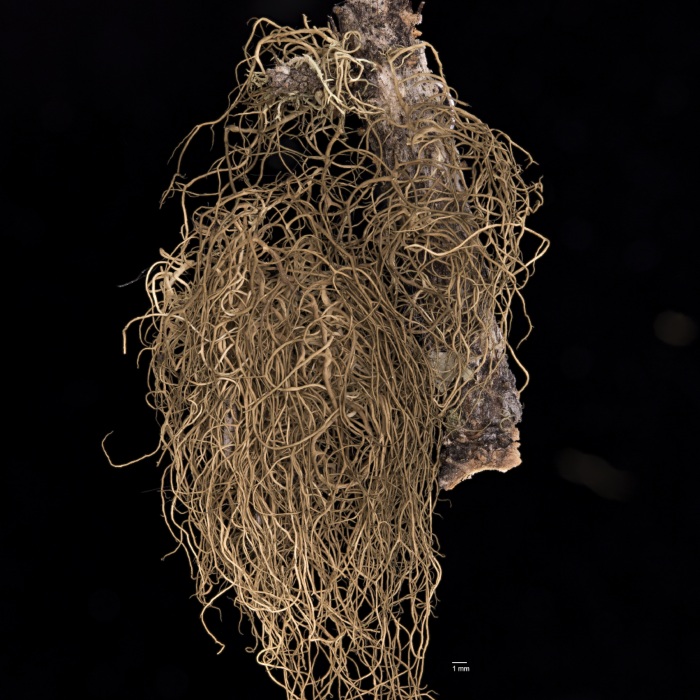 Photo Credit: D. Haughland
Photo Credit: D. Haughland
Horsehair lichens (genus Bryoria) feed Woodland Caribou in the winter when other food is scarce.
Lichens are our neighbours, living alongside us in cities, forests and grasslands. A few of the jobs these amazing symbiotic "organisms" perform are:
Lichens are excellent indicators of ecosystem health. Globally, they have been used as bioindicators for more than 150 years[7]. Lichens are exceptional bioindicators because:
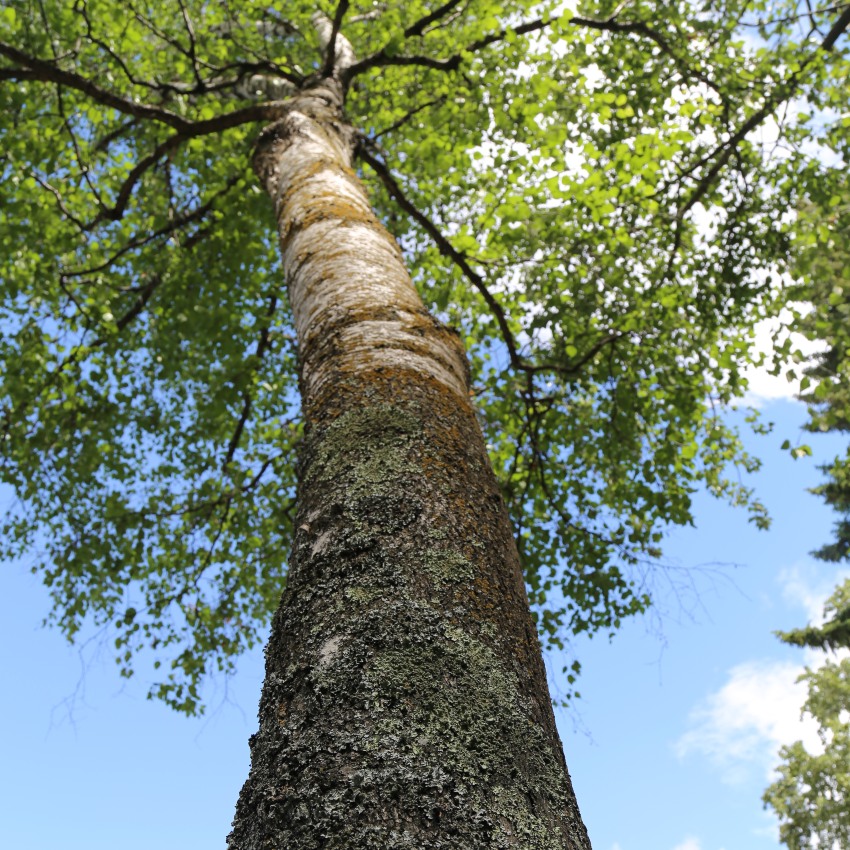 Photo Credit: D. Haughland
Photo Credit: D. Haughland
Tree-dwelling (epiphytic) lichens like those coating the trunk of this birch are excellent air quality biomonitors.
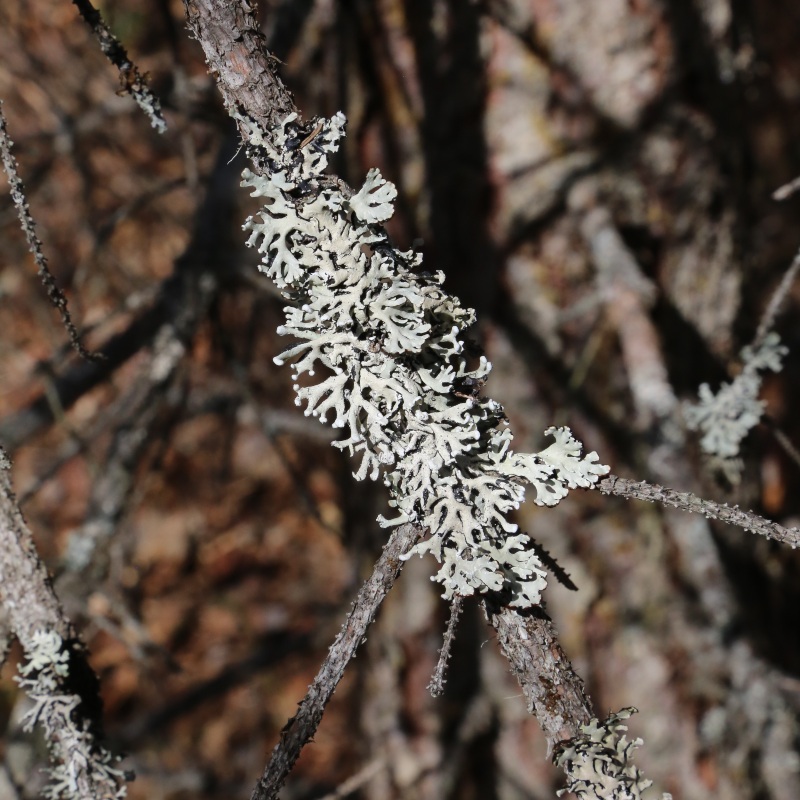
Hooded Tube (Hypogymnia physodes) is a proven biomonitor in the Alberta Oil Sands Region.
Lichens collected by the ABMI are not only a record of biodiversity at a given time and place, they also record the elements in that environment, absorbed from the moisture and dust deposited on their bodies. In collaboration with the Wood Buffalo Environmental Association, we are exploring the use of these biological archives to track changes in air quality and deposition across Alberta, including the Athabasca Oil Sands Region.
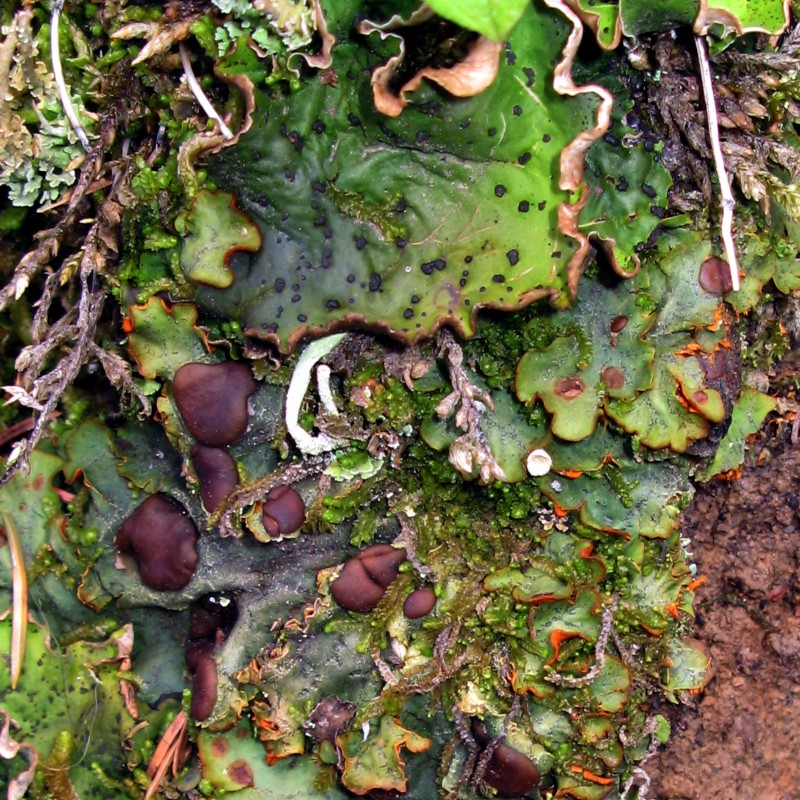
Freckle Pelt (Peltigera aphthosa) and Orange Chocolate Chip Lichen (Solorina crocea) growing together in the mountains.
A collaboration with the Lutzoni Lab at Duke University, this project started with documenting Alberta’s amazing Peltigera diversity through genetic work, and expanded to understanding what factors shape the distribution of all lichens with cyanobacterial partners across Alberta. Partially funded by a National Science Foundation grant to F. Lutzoni and J. Miadlikowska entitled “Spatio-temporal factors shaping cyanolichen networks”. Click here to find out more information.
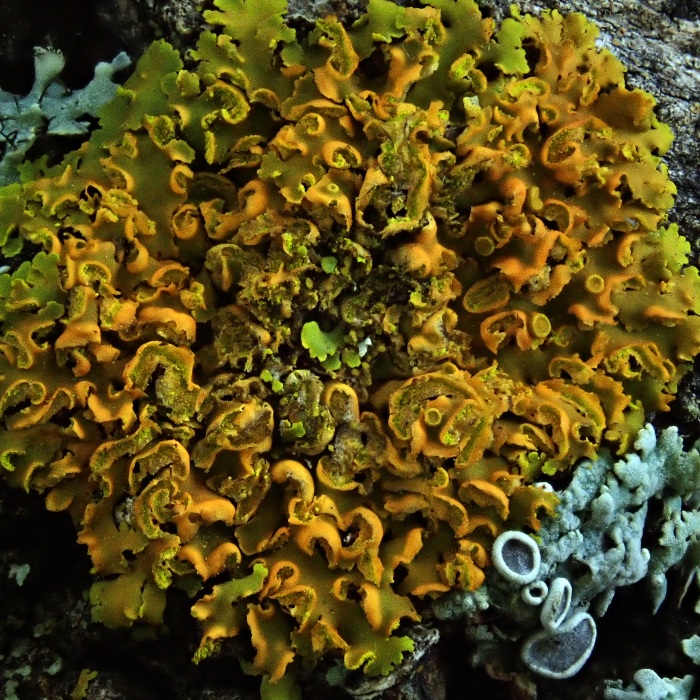
Hooded Sunburst (Xanthomendoza fallax) brightens Edmonton’s boulevard trees.
In collaboration with past students of the University of Alberta Lichens of Alberta class, we document the amazing lichen flora of Edmonton, and explore what lichens are telling us about climate and air quality within the city.
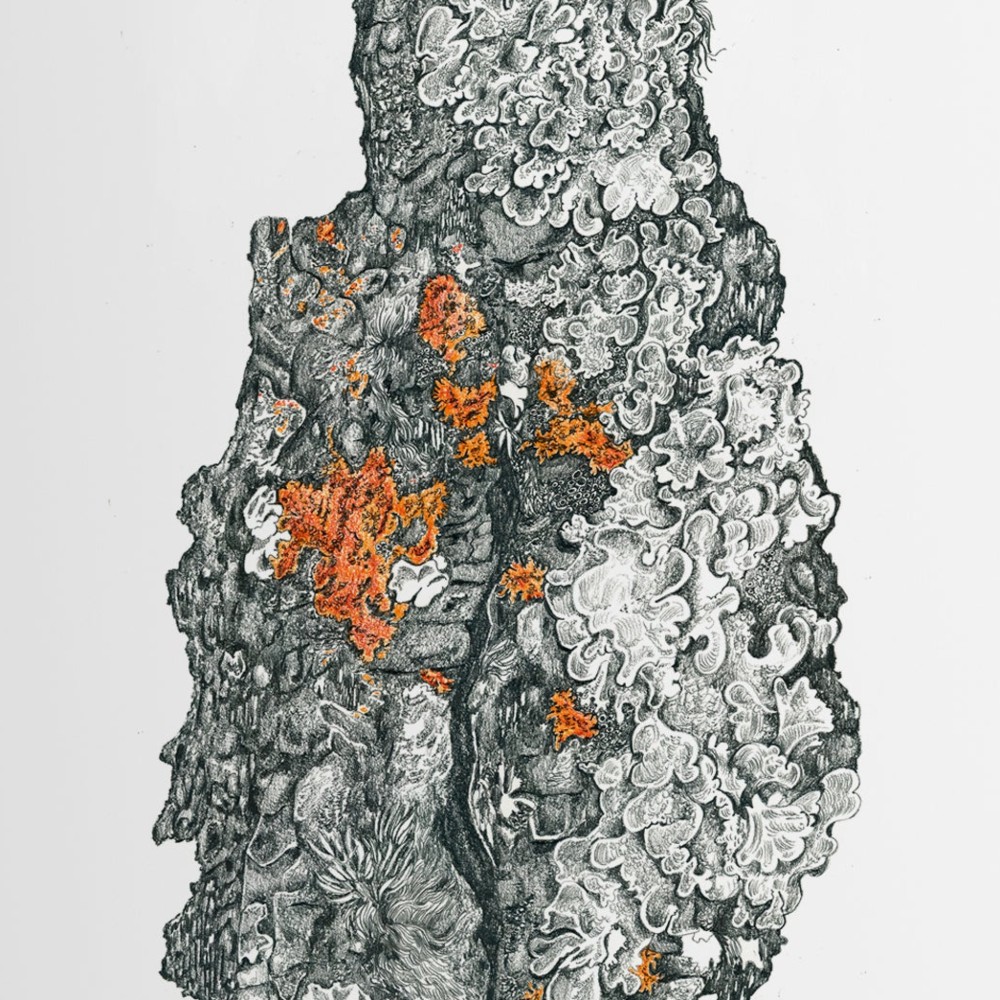
Illustration of Hooded Sunburst (Xanthomendoza fallax) by Amanda Schutz.
This collaboration with graphic designer and artist Amanda Schutz illustrates lichens that can be found around Edmonton. Based on collections and microscope sections, Amanda’s art invites you to see lichens from a different perspective. Click here for more information about this project or to see the illustrations.

Lichen Taxonomist
Darcie has been working as a lichen taxonomist for the ABMI since 2011. Her curiosity with lichen began after a snowboarding trip ended in a close encounter with a hair-lichen covered tree and she's been obsessed ever since.

Lichen Taxonomist
Jose joined the ABMI in 2022. He has a background in floristic surveys and vegetation monitoring, and brings his keen interest in lichen taxonomy and ecology, particularly calicioid (stubble) lichens, to the team.
If you have questions about the ABMI's lichen monitoring program, or to find out about the next Lichens of Alberta course at the University of Alberta (January 2025), please get in touch: diane.haughland@ualberta.ca
Alberta Biodiversity Monitoring Institute. 2021. Terrestrial field data collection protocols (abridged version). Alberta Biodiversity Monitoring Institute, Alberta, Canada. Report available here: https://abmi.ca/home/publications/601-650/601
Alberta Biodiversity Monitoring Institute. 2010. Laboratory protocols for processing lichens, Version 2010-05-31. Alberta Biodiversity Monitoring Institute, Alberta, Canada. Report available here: https://abmi.ca/home/publications/301-350/329
Coming soon. Contact Diane Haughland (email above) for copies of draft keys to the lichens of Alberta.
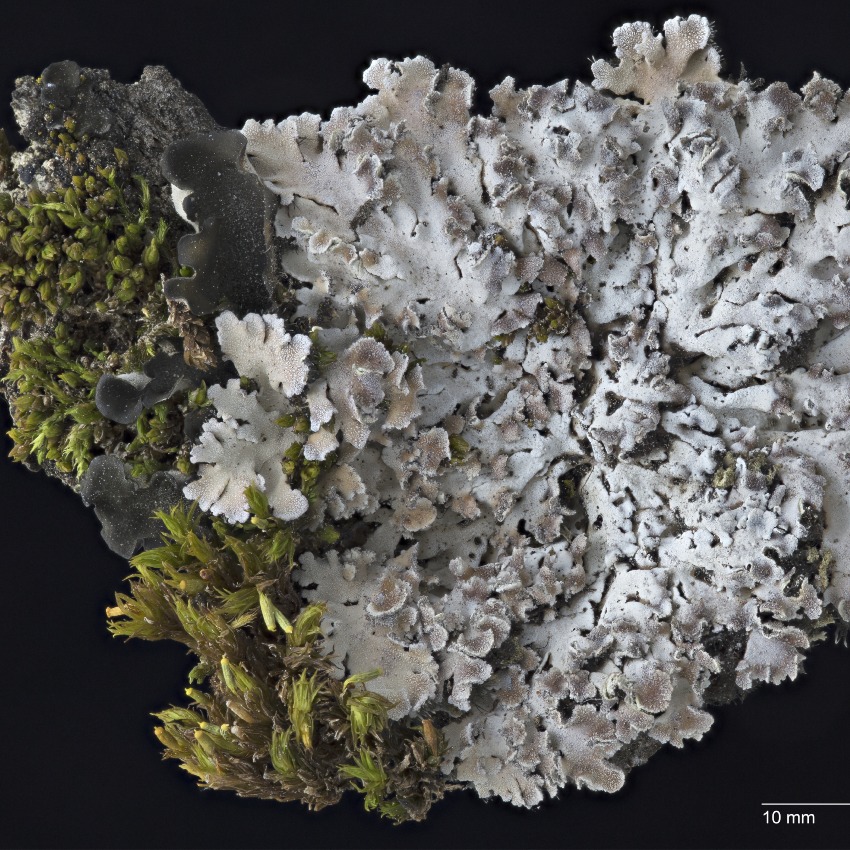 Photo Credit: Darcie Thauvette
Photo Credit: Darcie Thauvette
Lippy Frost Lichen (Physconia labrata) described from collections made near Hinton.
Haughland, D.L., A. Hood, D. Thauvette, S.A. Toni, M. Cao, J.D. Birch, J. Wasyliw, L. Hjartarson, M. Villeneuve, A. Stordock, D.A. Fielder, M. Lewis, D. Evans, D. Royko, R. Bolduc, H. Webster, J.D. Singh, K.A. Schafer, S. Goyette, H.E. Davidson, and C. Shier. 2022. Getting to know our biomonitor neighbors: urban lichens and allied fungi of Edmonton, Alberta, Canada. Opuscula Philolichenum. Pp 33-181. Available here: https://abmi.ca/home/publications/601-650/614
Haughland, D.L., A. Hillman, and E.T. Azeria. 2018. Tackling rarity and sample bias with large-scale biodiversity monitoring: a case study examining the status, distribution and ecology of the lichen Cladonia rei in Alberta, Canada. The Lichenologist 50(2): 211-230. https://doi.org/10.1017/S0024282918000099
Esslinger, T.L., B. McCune, and D.L. Haughland. 2017. Physconia labrata, a new species from western North America and Asia. The Bryologist 120(4): 427-434. https://doi.org/10.1639/0007-2745-120.4.427. Available here: https://www.abmi.ca/home/publications/501-550/538
Haughland, D.L. and M. Martel. 2016. Chaenothecopsis oregana new to Canada. Evansia 33: 34-39.
To view additional publications by Diane Haughland, click here.
For the love of lichens (2024). Nature Alberta article available here.
Why monitor lichens (2021). Presentation available here.
Explore the wondrous world of Alberta’s Lichens. Blog available here.
Lichen block party (2021). Presentation available here.
Understanding Alberta’s lichens (2013). Video available here.
The world beneath our feet: the mysterious nature of lichens. Blog part 1 available here and blog part 2 available here.
Muggia, L. and M. Grube. 2018. Fungal diversity in lichens: from extremotolerance to interactions with algae. Life 2018, 8, 15. doi:10.3390/life8020015.
Asplund, J. and D.A. Wardle. 2017. How lichens impact on terrestrial community and ecosystem properties. Biological Reviews 92: 1720-1738. doi: 10.1111/brv.12305.
Thomas, D.C., E.J. Edmonds, and W.K. Brown. 1996. The diet of woodland caribou populations in west-central Alberta. Rangifer 16: 37-342. doi.org/10.7557/2.16.4.1275.
Elbert, W., B. Weber, S. Burrows, J. Steinkamp, B. Büdel, M.O. Andreae, and U Pöschl. 2012. Contribution of cryptogamic covers to the global cycles of carbon and nitrogen. Nature Geoscience 5: 459-462. DOI: 10.1038/NGEO1486.
Jung, P., K. Baumann, D. Emrich, A. Springer, V.J.M.N.L. Felde, S. Dultz, C. Baum, M. Frank, and B. Büdel. 2020. Lichens bite the dust—a bioweathering scenario in the Atacama Desert. iScience 23: 101647. doi.org/10.1016/j.isci.2020.101647
van Zuijlen, K., R.E. Roos, K. Klanderud, S.I. Lang, and J. Asplund. 2020. Mat-forming lichens affect microclimate and litter decomposition by different mechanisms. Fungal Ecology 44:100905. doi.org/10.1016/j.funeco.2019.100905
Grindon, L.H. 1859. The Manchester flora. London.
Huggard, D. 2017. 6.2 Taxa summaries for Chapter 6 – technical report. ABMI 10 year review. https://abmi10years.ca/data/ABMI10yearReview-Supplementary-and-Technical-Documents.zip.
Conti, M.E. and G. Cechetti. 2001. Biological monitoring: lichens as bioindicators of air pollution assessment—a review. Environmental Pollution 114: 471-492. doi.org/10.1016/S0269-7491(00)00224-4.
Abas, A. 2021. A systematic review on biomonitoring using lichen as the biological indicator: a decade of practices, progress and challenges. Ecological Indicators 121: 107197. doi.org/10.1016/j.ecolind.2020.107197.
Ellis, C.J. 2012. Lichen epiphyte diversity: a species, community and trait-based review. Perspectives in Plant Ecology, Evolution and Systematics 14: 131-152. doi.org/10.1016/j.ppees.2011.10.001.
Ellis, C.J. 2019. Climate change, bioclimatic models and the risk to lichen diversity. Diversity 11: 54. doi:10.3390/d11040054.

.png)


